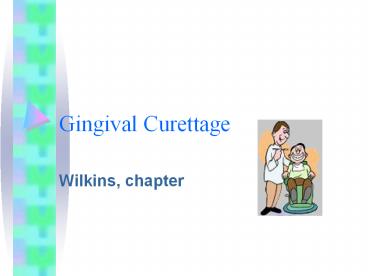Gingival Curettage - PowerPoint PPT Presentation
Title:
Gingival Curettage
Description:
Identify the indications & contraindications for gingival curettage. Describe the procedure ... Performed apical to epithelial attachment ... – PowerPoint PPT presentation
Number of Views:2579
Avg rating:3.0/5.0
Title: Gingival Curettage
1
Gingival Curettage
- Wilkins, chapter
2
Learning Objectives
- Distinguish between gingival and subgingival
curettage - Identify the indications contraindications for
gingival curettage - Describe the procedure
- Describe the healing that takes place following
curettage
3
Introduction
- Refers to the scraping of the pocket wall
- Separates diseased soft tissue
- Inadvertent curettage occurs with periodontal
debridement
4
Definitions
- Gingival Curettage
- Removal of inflamed soft tissue
- Removes diseased sulcular junctional epithelium
- Indications pseudopockets, shallow true pockets
- Objective gingival shrinkage
5
Definitions
- Subgingival Curettage
- Performed apical to epithelial attachment
- Removes connective tissue attachment down to
alveolar crest - Indications deep pockets
- Objectives reattachment
6
Rationale
- Removes granulation tissue
- Within granulation tissue we find
- Areas of chronic inflammation
- Bacteria, calculus
- Epithelial tissue lines granulation tissue
- May pose barrier to new fiber attachment
7
Rationale
- However,
- Granulation tissue slowly resorbs following
debridement - Bacteria eliminated
- Tissue heals
- Questionable
- Whether curettage significantly improves health
of tissue beyond what is seen with periodontal
debridement
8
Indications
- Generally limited
- Moderately deep infrabony pockets where new
attachment attempted - Closed surgery advised
- Technically difficult procedure
- Inadequate accessibility
- When surgical techniques not advised
- Due to age, systemic problems
- Goal of pocket elimination compromised
9
Indications
- Maintenance therapy
- In areas of chronic inflammation, especially if
client has had pocket reduction surgery
10
Basic Technique
- Periodontal debridement performed prior to
curettage - Tissues anaesthesized
- Appropriate selection of instruments
- Curettes, universal curette
- Curette blade placed against tissue
- Horizontal stroke
11
Basic Technique
- Irrigate tissues to flush out debris
- Gentle finger pressure applied to adapt tissues
- Separated interdental papillae may require
sutures - Surgical dressing may be indicated
12
Other Techniques
- Excisional New Attachment Procedure
- Ultrasonic Curettage
- Chemical Curettage
- Laser Fiber Curettage
- Students can do their own research on the above
techniques
13
Healing Following Debridement Curettage
- Uneventful healing
- Formation of long junctional epithelium
- No significant differences when compared to
debridement therapy alone
14
Curettage using Laser Fiber
Fiber tip slowly inserted into pocket kept
parallel to tooth Usually painless Moved apically
until pocket base reached
Vaporizing of pocket epithelium, subgingival
plaque some granulation tissue occurs
15
Curettage using Laser Fiber
Fiber, held in contact with root surface, is
slowly moved coronally withdrawn This vaporizes
microbial debris on root surface Any remaining
deposits can be removed with a curette
16
Results of Curettage - Laser Fiber
Before treatment pockets measure 7-8 mm
17
Results of Curettage - Laser Fiber
Just after treatment
3 months after treatment 3 mm pockets






























